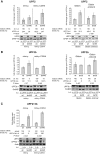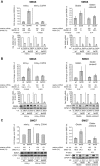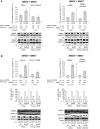Comparison of EJC-enhanced and EJC-independent NMD in human cells reveals two partially redundant degradation pathways
- PMID: 23962664
- PMCID: PMC3854533
- DOI: 10.1261/rna.038893.113
Comparison of EJC-enhanced and EJC-independent NMD in human cells reveals two partially redundant degradation pathways
Abstract
Nonsense-mediated mRNA decay (NMD) is a eukaryotic post-transcriptional gene regulation mechanism that eliminates mRNAs with the termination codon (TC) located in an unfavorable environment for efficient translation termination. The best-studied NMD-targeted mRNAs contain premature termination codons (PTCs); however, NMD regulates even many physiological mRNAs. An exon-junction complex (EJC) located downstream from a TC acts as an NMD-enhancing signal, but is not generally required for NMD. Here, we compared these "EJC-enhanced" and "EJC-independent" modes of NMD with regard to their requirement for seven known NMD factors in human cells using two well-characterized NMD reporter genes (immunoglobulin μ and β-Globin) with or without an intron downstream from the PTC. We show that both NMD modes depend on UPF1 and SMG1, but detected transcript-specific differences with respect to the requirement for UPF2 and UPF3b, consistent with previously reported UPF2- and UPF3-independent branches of NMD. In addition and contrary to expectation, a higher sensitivity of EJC-independent NMD to reduced UPF2 and UPF3b concentrations was observed. Our data further revealed a redundancy of the endo- and exonucleolytic mRNA degradation pathways in both modes of NMD. Moreover, the relative contributions of both decay pathways differed between the reporters, with PTC-containing immunoglobulin μ transcripts being preferentially subjected to SMG6-mediated endonucleolytic cleavage, whereas β-Globin transcripts were predominantly degraded by the SMG5/SMG7-dependent pathway. Overall, the surprising heterogeneity observed with only two NMD reporter pairs suggests the existence of several mechanistically distinct branches of NMD in human cells.
Keywords: endo- and exonucleolytic mRNA degradation; UPF1; UPF2; UPF3b; SMG1; SMG5; SMG6; SMG7; exon-junction complex; mRNA surveillance; mRNA turnover; nonsense-mediated mRNA decay; post-transcriptional gene regulation.
Figures





Similar articles
-
Dissecting the functions of SMG5, SMG7, and PNRC2 in nonsense-mediated mRNA decay of human cells.RNA. 2018 Apr;24(4):557-573. doi: 10.1261/rna.063719.117. Epub 2018 Jan 18. RNA. 2018. PMID: 29348139 Free PMC article.
-
CK2-mediated TEL2 phosphorylation augments nonsense-mediated mRNA decay (NMD) by increase of SMG1 stability.Biochim Biophys Acta. 2013 Oct;1829(10):1047-55. doi: 10.1016/j.bbagrm.2013.06.002. Epub 2013 Jul 3. Biochim Biophys Acta. 2013. PMID: 23831331
-
Processing bodies are not required for mammalian nonsense-mediated mRNA decay.RNA. 2009 Jul;15(7):1265-73. doi: 10.1261/rna.1672509. Epub 2009 May 27. RNA. 2009. PMID: 19474145 Free PMC article.
-
Cutting the nonsense: the degradation of PTC-containing mRNAs.Biochem Soc Trans. 2010 Dec;38(6):1615-20. doi: 10.1042/BST0381615. Biochem Soc Trans. 2010. PMID: 21118136 Review.
-
Nonsense-Mediated mRNA Decay: Degradation of Defective Transcripts Is Only Part of the Story.Annu Rev Genet. 2015;49:339-66. doi: 10.1146/annurev-genet-112414-054639. Epub 2015 Oct 2. Annu Rev Genet. 2015. PMID: 26436458 Free PMC article. Review.
Cited by
-
Nonsense-Mediated mRNA Decay as a Mediator of Tumorigenesis.Genes (Basel). 2023 Jan 30;14(2):357. doi: 10.3390/genes14020357. Genes (Basel). 2023. PMID: 36833284 Free PMC article. Review.
-
Amlexanox and UPF1 Modulate Wnt Signaling and Apoptosis in HCT-116 Colorectal Cancer Cells.J Cancer. 2019 Jan 1;10(2):287-292. doi: 10.7150/jca.28331. eCollection 2019. J Cancer. 2019. PMID: 30719122 Free PMC article.
-
From Yeast to Mammals, the Nonsense-Mediated mRNA Decay as a Master Regulator of Long Non-Coding RNAs Functional Trajectory.Noncoding RNA. 2021 Jul 27;7(3):44. doi: 10.3390/ncrna7030044. Noncoding RNA. 2021. PMID: 34449682 Free PMC article. Review.
-
Nonsense-Mediated RNA Decay Is a Unique Vulnerability of Cancer Cells Harboring SF3B1 or U2AF1 Mutations.Cancer Res. 2021 Sep 1;81(17):4499-4513. doi: 10.1158/0008-5472.CAN-20-4016. Epub 2021 Jul 2. Cancer Res. 2021. PMID: 34215620 Free PMC article.
-
Regulation of gene expression by translation factor eIF5A: Hypusine-modified eIF5A enhances nonsense-mediated mRNA decay in human cells.Translation (Austin). 2017 Aug 14;5(2):e1366294. doi: 10.1080/21690731.2017.1366294. eCollection 2017. Translation (Austin). 2017. PMID: 29034140 Free PMC article.
References
-
- Amrani N, Ganesan R, Kervestin S, Mangus DA, Ghosh S, Jacobson A 2004. A faux 3′-UTR promotes aberrant termination and triggers nonsense-mediated mRNA decay. Nature 432: 112–118 - PubMed
-
- Andersen CB, Ballut L, Johansen JS, Chamieh H, Nielsen KH, Oliveira CL, Pedersen JS, Seraphin B, Le Hir H, Andersen GR 2006. Structure of the exon junction core complex with a trapped DEAD-box ATPase bound to RNA. Science 313: 1968–1972 - PubMed
Publication types
MeSH terms
Substances
Grants and funding
LinkOut - more resources
Full Text Sources
Other Literature Sources
Research Materials
